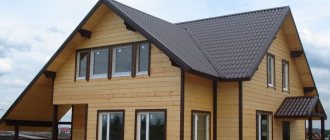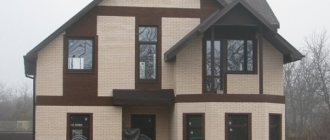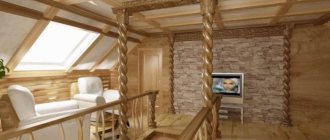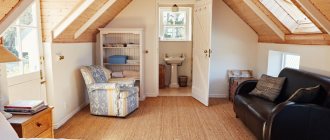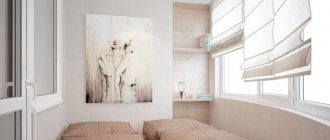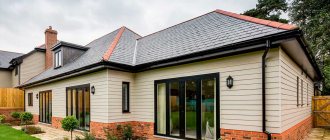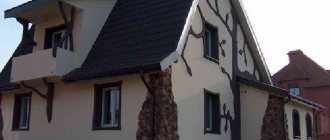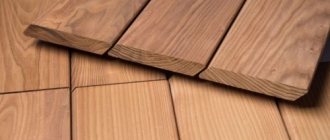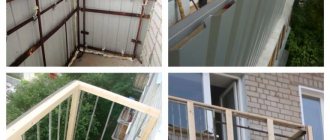The issue of cladding a house is one of the most difficult, because it needs to be beautiful and durable, but not expensive. And also, so that everything can be done very quickly, since cladding is the final stage of construction, and you want to finish everything quickly.
Do modern façade materials such finishing? Quite. Their range is very wide, and in order to choose a specific material, you need to have a general idea of each: what it is, how much façade material costs, pros and cons, service life and installation nuances.
Requirements for façade cladding materials
House cladding performs two functions:
- Decorative. It makes the facade beautiful and aesthetic, sets and emphasizes the style of the building, and makes it stand out from the surrounding buildings.
- Protective. Protects the walls and interior of the house from atmospheric influences.
In order for the finished cladding to perform both functions, all facade materials must have:
- Low thermal conductivity - allows you to retain heat inside the house.
- Increased or absolute fire resistance - for protection against fires and the spread of fire in the event of a fire.
- Sufficient vapor permeability - for a favorable microclimate inside the house and protection of the insulation from condensation.
- High moisture resistance - to prevent the absorption of moisture, which leads to destruction of the material.
- Resistant to chemicals, fungus, microorganisms, rodents and insects.
- Resistant to sunlight, so as not to fade in the sun and maintain its decorative qualities throughout its entire service life.
Important : the cladding must provide not only an insulation effect, but also sufficient sound insulation to protect the interior from extraneous sounds.
How can you decorate the façade?
The facade of a building is not only its face, but also its protection. Facade materials must protect the building structure from changes in temperature and humidity, from precipitation, wind and ultraviolet radiation, as well as from mechanical influences. The question arises - how to choose finishing solutions that will reliably protect the house and, at the same time, meet the basic requirements:
- compatibility with building construction materials;
- relative simplicity and speed of installation;
- low load on the building foundation;
- strength and durability of the cladding;
- attractive appearance of the building;
- affordable cost of finishing materials and installation work.
The choice of material for finishing the facade of a house should, first of all, be based on the characteristics of the building itself - what the buildings are made of, its purpose, climatic conditions, the surrounding landscape, the taste and preferences of the customer. The second most important factor of choice is the budget for construction and finishing works.
In this article, we will consider all the options that modern manufacturers of facade materials offer, and we will determine the best finishing solutions, taking into account the above factors.
Cladding a house with facade panels
An inexpensive option for cladding a house is façade panels. This is the same PVC siding, but with a slightly different shape - in the form of a rectangle. They can be mounted both on the sheathing and on the walls, if they are smooth enough. Average sizes of facade panels:
- Width – 320-460 mm.
- Length – 1000-1550 mm.
- Thickness – 0.7-1.2 mm.
Advantages of facade panels:
- light weight for easy installation;
- corrosion resistance;
- resistance to moisture, rot and fungus;
- self-cleaning ability (dirt is easily washed off by rain);
- possibility of installation in horizontal and vertical directions;
- a large selection of colors and textures (the panels naturally imitate wood, stone and brickwork);
- service life – up to 50 years.
We advise you to study : “Calculation of facade panels. Types of stone imitations."
What does the finishing of facade panels look like?
Price for facade panels
The cost of facade panels is determined by their design and manufacturer. Today the most popular brands of this material are:
- Docke (Germany). Price – from 360 rub./piece.
- FineBeer (Russia). Price – from 440 rub./piece.
- Grand Line (Belarus). Price – from 260 rub./piece.
- "Yu-plast" (Russia). Price – from 260 rub./piece.
We advise you to study : “Full review of Grand Line facade panels: characteristics, design, analogues, advantages, installation technology.”
Sheathing a house using sheathing
In general, there are two options for cladding a house:
- Directly onto the walls, protected from the inside by a layer of vapor barrier. In this case, lathing is not needed. In this way, plastering is often done on brick and reinforced concrete walls.
- On the sheathing. This is a ventilated facade system in which there is a gap between the finishing and the walls, in which, as a rule, the insulation is located.
We advise you to study in more detail: “All types of insulation: classification by properties and composition.”
The lathing is made of a metal profile or wooden blocks with a cross-section of 40x40 mm, a humidity of no more than 15-20% and impregnated with fire and bioprotection. Markings are made on the wall first.
Sheathing made of metal profile
On average, the lathing pitch is 300-400 mm, but it is important to consider the length (for vertical slats) and width (for horizontal slats) of the material used. Also, profiles must be attached around window and door openings.
A heat-insulating material is installed between the bars, which is secured with mushroom anchors. The insulation is covered on top with a superdiffusion membrane, fixed to the staples of a construction stapler. After this, you can begin sheathing.
We advise you to study in more detail : “FAKRO waterproofing membrane: its functions, scope of application, types and installation technology.”
Please note : for greater rigidity of the wooden sheathing, horizontal slats can be additionally attached between the main vertical bars.
General information
House decoration can be divided into two types:
| Finish type | Peculiarities |
| Coating walls with liquid protective compounds | Such compositions include:
In this case, the walls are simply treated with protective coatings, after which they become more resistant to environmental influences. |
| Facing | The facade is finished with special facing materials, such as:
|
Below we will take a closer look at all the finishing options.
Antiseptic impregnation for wood
Types of decorative cladding
Modern materials for house cladding allow you to imitate various types of finishes. So, a brick building can be transformed into a wooden frame, and on a wooden wall, on the contrary, an imitation of brickwork can be done. The following materials are used for this:
- siding;
- wooden lining;
- block house;
- ceramic or stone tiles;
- thermal panels.
How to sheathe a wooden house:
- vinyl, wood or metal siding;
- clapboard (it will be more expensive than with siding, but the finish will be more presentable);
- a block house that imitates a rounded log (outwardly reminiscent of the usual lining);
- decorative plaster (first, heat-insulating boards are installed, which are reinforced with mesh).
Brick houses are more durable and can withstand more weight. Therefore, there are more finishing options here. What is the best way to sheathe a brick house:
- Siding is the most economical and simple solution. Fiber cement, metal and vinyl siding are suitable.
- Facade clinker bricks. Suitable for finishing buildings made of building blocks. It absorbs water poorly due to its manufacture from refractory clays. This allows the material to be used in any climate zone.
- Insulated plaster is a type of “wet facade” that is in great demand.
- Facade tiles are an inexpensive and practical material with good insulating characteristics.
- Natural stone: slate, sandstone, quartzite, marble, granite. This is the most expensive finishing option and requires care and careful handling.
- Artificial stone is a good alternative to natural stone. Made from polymers, resins, ceramics or concrete.
We advise you to study : “Calculation of decorative artificial stone. How it is produced and where it is used.”
For a frame structure, due to its lightness, it is recommended to use lightweight cladding options. The optimal choice is siding, which is lightweight and economical, and also allows for high-quality insulation. You can also use the same lining, block house and even plaster.
Clinker thermal panels
One of the most modern materials for finishing a house outside are linker thermal panels. They are multi-layered:
- The bottom layer is thermal insulation. It is presented in the form of insulation: polystyrene foam or polyurethane foam, which have good thermal insulation.
- The top layer is decorative. Most often represented by clinker tiles, which have maximum strength and very high frost resistance. The tile very naturally imitates brickwork, makes the facade aesthetic and neat, and also protects the insulation from wind, precipitation and sunlight.
Joining clinker panels
Due to this structure, clinker thermal panels simultaneously act as both insulation and decorative finishing. This allows you to speed up the installation process, since the stage of covering with thermal insulation boards is skipped. The advantages of thermal panels are also noted:
- high density of panel joints, eliminating the penetration of cold air;
- low percentage of water absorption (you can wash the facade with water from a hose);
- light weight (a strip foundation is sufficient, no reinforcement is required);
- quick and easy installation directly on the wall.
Installation of thermal panels
Thermal panels have a special tongue-and-groove locking system, which ensures very tight adhesion of individual elements. To finish the entire facade, manufacturers produce straight and wall thermal panels, as well as corner elements for them.
General panel installation technology:
- Preparing walls: eliminating irregularities, depressions, chips and other defects.
- Lathing installation - necessary when installing on a surface with uneven surfaces, for example, a log house. For the required rigidity, each thermal panel must be attached simultaneously to 3 sheathing bars. For example, let's take the Cherry rustik thermal panel (price from 2,250 rubles/m2) with a length of 1050 mm. To place it on three vertical bars, they must be spaced in 350 mm increments (1050/3 = 350 mm).
- Direct installation of thermal panels. They are attached to the sheathing using self-tapping screws and dowels, and to the walls using an adhesive composition intended for outdoor use.
- Grouting joints if the panels were laid using joint technology. This is necessary for the final insulation of the insulation.
How to install thermal panels directly on the wall
Imitation timber or blockhouse
Although new trends are constantly appearing on the market of materials for exterior wall finishing of a house, people’s love for cladding with natural wood remains quite strong. Material imitating timber or blockhouse remains at the peak of popularity and is suitable for finishing walls built from any material.
Block house.
Imitation of timber.
Appearance
To make imitation timber and blockhouses, larch, cedar, pine or spruce wood is most often used. A profile with a rounded surface imitates a blockhouse, and a profile with a flat side imitates laminated veneer lumber.
The planks are connected using a tongue-and-groove system. If the installation is done correctly, then even upon close examination it seems that the house is made of natural timber or built of logs. To enhance the effect and protect wood from moisture, paint and varnish coatings are used. But here it is important not to overdo it, since bright colors make the wood look less natural.
The house is covered with imitation timber.
The house is covered with a blockhouse.
Price
The cost of cladding a house with such material depends on the type of wood and type of product. For example, larch is resistant to moisture penetration and costs 2-3 times more than pine, which has increased hygroscopicity.
By type of variety there are three main options:
- A - the best, without cracks, knots, or other defects.
- B - there are small defects in the form of microcracks, resinous spots, knots.
- C is the cheapest grade, since cracks, chips, fallen knots, in place of which there are gaping holes, are possible.
Sometimes manufacturers offer not pure, but mixed varieties, where there is a profile of both types, this is the so-called AB grade, it is best used for exterior decoration of a house.
Durability and practicality
Natural wood is responsible for the strength here, which cannot be broken or bent with a light blow. Installation is quick and not complicated. The array improves sound and heat insulation. In terms of strength and practicality, this material will be an order of magnitude higher than the previously discussed types of siding.
Care
The exterior of the house requires periodic treatment with an antiseptic to protect the wood from rotting. If this is done in a timely manner, the material will last 50 years. All types of wood need care, including larch, although there are fewer problems with it.
Maintainability
To replace a damaged plank, you will need to dismantle the entire wall sheathing.
Covering a house with siding
When considering the question of how to cover the outside of a house cheaply, first of all it is necessary to talk about siding. This material:
- resistant to mechanical stress;
- has fire safety;
- not susceptible to insects and microorganisms;
- reliably protects walls from wind and precipitation;
- not exposed to sunlight;
- has no toxicity;
- easy to install and affordable.
The most popular finishing materials in this category are:
- Vinyl siding. The most popular and inexpensive. Material – polyvinyl chloride (PVC). Resistant to chemicals, can be used at any temperature. With a small thickness, the siding has sufficient rigidity. Price – from 100 rub./piece.
- Fiber cement siding. It consists of 90% composite cement and 10% fiber - thin glass, polymer or cellulose fiber that has a reinforcing effect. Price – from 800 rub./piece.
- Metal siding. The most durable and strong. Material – thin sheet profiled steel with zinc coating and a layer of powder paint. Price – from 300 rub./m2.
We advise you to study : “Vinyl siding: how to install and calculate everything you need.”
Types of fiber cement siding
There are many different brands of fiber cement siding on the market. One of the popular ones is Cedral. The manufacturer's line includes 2 series: Smooth with a smooth, slightly textured surface and Wood with a texture similar to cedar wood.
Cedral siding also has 2 installation options: Cedral (installation with a slight overlap) and Cedral Click (installation butt-to-butt). The advantage of the material is also a large selection of colors - 30 shades of light and dark tones.
Fiber cement siding Cedral with overlap installation
Prices for fiber cement siding using Cedral as an example:
- Cedral Click Smooth (186x3600 mm) – 1300-1500 RUR/piece.
- Cedral Click Wood (186x3600 mm) – 1200-1300 RUR/piece.
- Cedral Smooth (190x3600 mm) – 1000-1200 RUR/piece.
- Cedral Wood (190x3600 mm) – 800-100 RUR/piece.
Installation of siding panels
Siding is the best material for cladding the outside of a house also because of its ease of installation. Each panel has special holes for fastening to the sheathing. Self-tapping screws are screwed through them right in the middle, leaving at least 1-2 mm between the head and the surface of the panel as a gap in case of thermal expansion.
How to attach siding to sheathing
Features of fastening additional elements
Installation is carried out in the direction from bottom to top. All panels coming after the first one are inserted into the lock of the underlying one, after which they press on it until it snaps into place. The maximum length of siding is 6 m. If the building wall is longer, then during installation it is necessary to use a joining profile. The set of additional elements also includes external and internal corners, ebbs, window and door slopes.
A complete set of additional elements for siding installation
Metal siding
Modern metal siding is no longer used only for cladding industrial facilities. The material is widely used in the decoration of private houses. The service life of metal siding reaches 50 years. All thanks to the special structure and protection from several layers at once:
- zinc coating providing corrosion resistance;
- a primer that increases adhesion between metal and paint;
- polymer powder paint, which is a protective and decorative film.
Powder coating protects the metal from moisture and sunlight, and also gives the siding a certain color or texture of natural materials: logs, ship planks, block houses, timber, stones, bricks.
Metal siding finishing
Metal siding prices
- “Ecosteel ship board” – 685 rub. /m2.
- “Under a log Block House Ecosteel” – 700 rubles. /m2.
- “Under the log Block House Polyester” – 350 rub. /m2.
- “Under timber Polyester” – 350 rub. /m2.
- “Under Ecosteel timber” – 710 rubles. /m2.
- “Ship plank” – 300 rubles. /m2.
Metal siding profile
Installation of metal siding
Metal siding is installed in the same way as vinyl or fiber cement siding. General technology includes:
- Preparing walls and applying markings.
- Lathing device.
- Fastening thermal insulation boards (most often mineral wool) between the lathing slats, and on top - waterproofing.
- Cut out the panels for further work.
- Installation of the starting strip, external and internal corners.
- Installation of siding on the sheathing.
Installation of the starting bar
Installation of internal and external corners
We advise you to study : “What you need to know about basalt insulation: composition, characteristics, pros and cons, types and overview of popular manufacturers.”
Comparison of prices for materials and work on arranging the facade of a house
The world of cladding for private houses contains a large selection of materials that can transform the appearance, significantly improve thermal insulation, and reliably protect walls from rain and wind. If we focus only on budget options, which have received a lot of positive reviews and general popular recognition, then we can highlight thermal panels, siding, plaster, fiber cement panels and imitation timber. The comparative table below shows their prices per 1 sq. m. when covering a house, cost of work, average rating for appearance.
| Type of finish | Average price of material, 1 m2/rub. | Average cost of installation work, 1m2/rub. | Full cost, 1m2/rub. | Appearance |
| Vinyl siding | 400 | 500 | 900 |

